Wiring diagram in the apartment: electrical wiring for different rooms
An obligatory part of the repair work in the apartment is the replacement or installation of electrical cables, junction boxes, electrical panels. A correctly selected wiring diagram will protect the housing from accidents and unforeseen situations.
We will tell you what you need to provide for when replacing or laying electrics yourself. Here you will learn how to make a diagram and distribute electrical points in one-room, two- and three-room apartments. Based on our recommendations, you can provide yourself with a faultlessly functioning energy network.
The content of the article:
Distinctive features of modern wiring
Modern household technologies at the end of the 20th century made a tangible breakthrough. In addition to TVs, computers, security and video surveillance systems, powerful household appliances, and wireless communications appeared in homes. In this regard, the wiring of electric cables has become much more complicated, although the principles of the device have not changed.
Difficulties begin from the very first stage - design. In order to correctly draw up the wiring diagram in the apartment, you need to know in advance the approximate power of household electrical appliances, their location. At the same time, you need to think through a lighting system in all rooms.
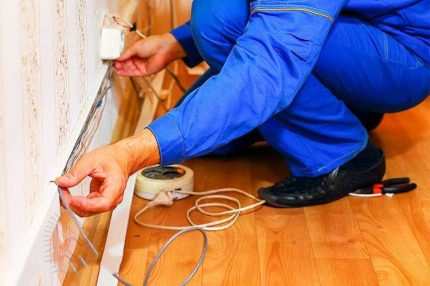
In addition to a large number of new devices, another difference appeared: along with the power network, a low-current system is always present, traditionally including telephone and television wires, as well as computer, security, acoustic equipment and an intercom.
These two systems (power and low current) cannot be separated, since all devices are powered by 220 V.
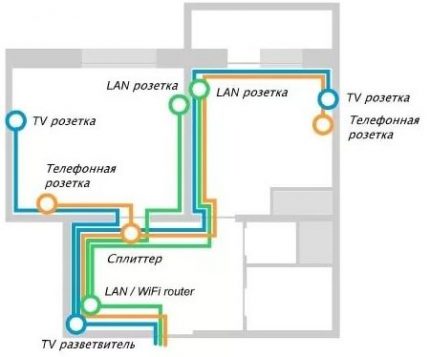
The number of instruments and cables operated simultaneously has changed. If earlier it was enough to install one chandelier in the hall, now many people use a lighting system that includes, in addition to the chandelier, spotlights and lights.
An increase in power must be added to the increase in the number of equipment - for this reason, the old cables are no longer suitable, and the size of the electrical distribution panel has grown significantly.
Why do I need a wiring diagram?
It turns out that the device of modern wiring of electricians in an apartment is a real art, which only a professional electrician can cope with.
If you don’t want to constantly change the wall decoration in order to mask the cables appearing here and there, we recommend that you make a drawing with the designation of all significant objects related to electricity: sockets, switches, electrical panels, before repairing an apartment or building a house RCDlighting fixtures.
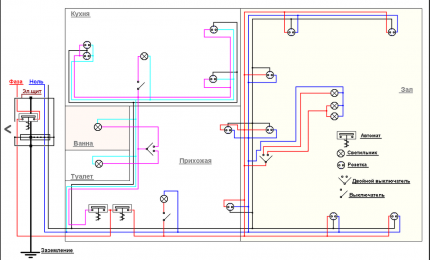
Based on the requirements or wishes of the homeowner, an electrician draws up a schematic diagram of the electrical wiring in the apartment. Its task is to divide the cables into groups in order to correctly distribute the load, to think through a control and protection system and, ultimately, to do everything to guarantee safety and comfort.
What you must take into account when drawing up a diagram, drawing, work plan necessary for a competent electrical wiring?
Consider the power grid in terms of constituent parts:
- Automatic protection devicesinstalled in an electrical panel. The functioning of all home equipment and the safety of users depend on their quality and proper installation.
- Cable wire with the right section and good insulation.
- Sockets and switches with quality contacts, secure enclosures.
In private homes, an obligatory element is an introductory machine and a power cable from it to the shield. Via circuit breaker regulate the power consumption and, if necessary, turn off all the electricity in the house.

An electric meter is usually installed at the entrance, a cut after the introductory machine.
Division of wiring into groups (lines)
It is much easier to manage and control the power grid if it is divided into several lines. In the event of a malfunction or emergency, you can turn off one group, while the rest will function normally.
The option of dividing into 4 groups:
Further about each electrogroup in more detail.
Stationary household appliances
Large household appliances are usually located in the kitchen or bathroom area.
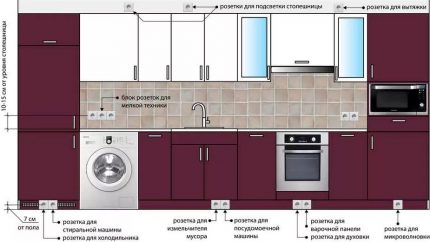
Separate connection of the kitchen area is necessary for repairs. If one of the devices breaks down, a replacement is required. In order not to turn off the electricity in the entire apartment, it is enough to turn off one protection device, which is responsible for stationary equipment.
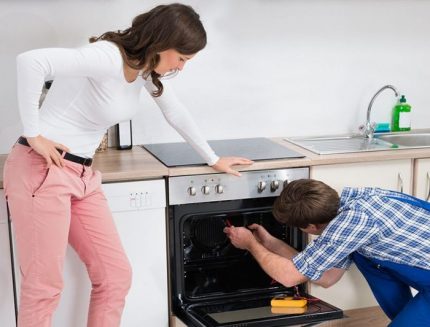
What prevents you from simply disconnecting the broken device from the network by pulling the plug from the outlet? The fact is that with built-in equipment, the points of connection to the mains are located in hard-to-reach places.
In addition, a malfunction can occur not in the device itself, but in the wiring disguised in the wall. In this case, moving the lever of the circuit breaker is much easier.
Leased line for the kitchen
The kitchen line is traditionally the busiest. About 5-6 units are constantly connected to the network, even if they are not involved. This applies to the refrigerator, oven, hob, dishwasher, range hood, microwave, toaster. Many people use a kitchen electric grill, a meat grinder, a bread machine, a slow cooker, etc.

In this case, a separate powerful electric cable will simply make it possible to use several devices at once.
If lighting devices or a water heater “hang” on the general wiring, then when you turn on the next device, the network simply will not stand up and an automatic shutdown will work.
Detailed analysis of schemes and location options kitchen outlets given in the article, which we recommend to read.
One or more lighting groups?
Given the number of lighting fixtures in each room, one or more lines can be made. If the hall has one six-arm chandelier, and the bedroom has low-power overhead lighting and two sconces, then all the devices can be combined in one line.
However, if the living room resembles a hall for a disco - with chandeliers, spotlights, ceiling and wall lights - then only for it should organize a separate group.
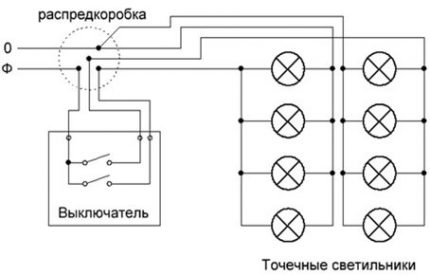
If, in addition to the luminaires, transformers or power supplies are included in the network of one room, then it is also recommended to connect it to a separate protection device.
Humid rooms
Elevated requirements apply to electrical appliances and cable in the bathroom, since the close proximity of water is a risk. In order for the power grid to be safe and functional, a number of rules must be taken into account when drawing up the circuit and installing the wiring:
The requirements also apply to the choice of accessories that you will have to use regularly - sockets and switches. Suppose that the degree of protection of the sockets should be at least IP 44, and it is even better to purchase special devices with a splash-proof cover.
It is recommended to abandon 220 V luminaires in favor of 12 V analogs.
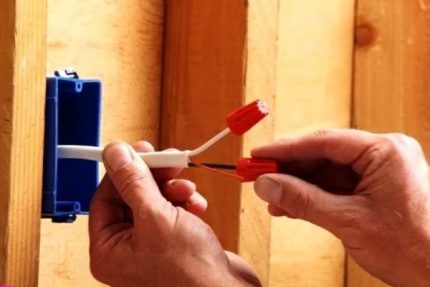
If grounding is not provided for in the old housing in the apartment panel, then not only in the bathroom, but throughout the apartment, the electrical wiring will have to be replaced with a three-wire one.
With selection rules waterproof sockets For the arrangement of bathrooms and toilets, we suggest that you familiarize yourself with the article on these issues.
Overview of wiring diagrams for residential premises
Let's move on to specific schemes that can be applied in the planning process of wiring in your own room. When drawing up the drawing, it is important to take into account the arrangement and power of stationary equipment, the conditions for using electrical appliances, and the convenient placement of sockets and switches for use.
Option # 1: studio or studio
A distinctive feature of one-room housing is the minimum, in comparison with other options, the number of electrical appliances, respectively, a smaller number of connected lines is formed. But this does not mean that for the kitchen or the bathroom you do not need to plan separate groups - it is better to preserve the general principles.
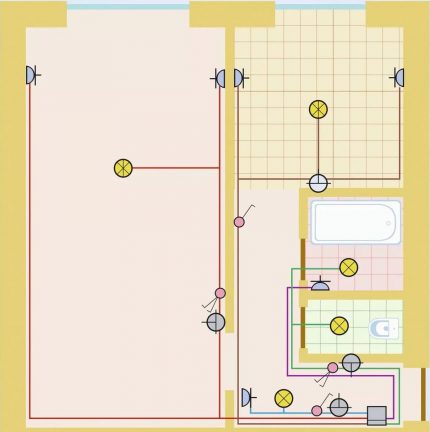
Consider what should definitely be done when drawing up an electrical wiring diagram in a one-room apartment:
- choose the main parameters of the electric network;
- calculate the load, pick up the cable and RCD;
- select a connection scheme (1 or several groups).
Having solved these issues, drawing up a diagram will be much easier.
Electric network parameters
It is difficult to decide in advance which devices will be installed in the entire apartment, however, at least an approximate number of them is necessary in order to correctly calculate the total power.
It is important to determine their location, as the use of extension cords and filters in the future will create additional problems for the network and ruin the interior design.
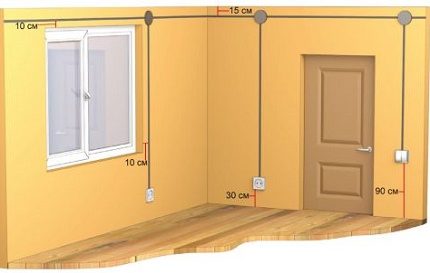
It is also important to choose the method of laying cables - open or closed. Open way involves laying wires over decorative walls. In this case, most often the wiring is covered with plastic boxes, but in some cases left in sight.

Benefits of open wiring:
- possibility of installation after or during repair work;
- quick installation;
- You can connect another line at any time.
When installing hidden wiring, you will have to ditch the walls so that all wires are masked under the finish. Easier with pendant structures: the hoses for the lighting system can be hidden above the tension coating or plasterboard box.
Hidden wiring has a few pluses, but they are more significant:
- not so stringent requirements are imposed on the parameters and installation conditions;
- tolerances to nominally allowed currents increase;
- interior integrity is maintained.
Traditionally, in new apartments, they use hidden wiring, and use the open method only as an exception (for example, when laying a new line in an already renovated apartment).
Electricity load calculation
In order to calculate the total load of electrical appliances, it is necessary to know the rated power of the electrical receivers, the rated current and the voltage of the mains. There are many calculation formulas, but it is better to use ready-made tables.

We recommend that you contact an engineer or use a computer program to calculate the exact load, because it depends on the result cable selection.

According to the rules, if the intra-apartment networks are divided into groups, then each individual line must be equipped with a 25 A automatic machine. Therefore, when breaking down into groups, we take into account the total rated current (not more than 25 A).
There are exceptions: for example, for lighting networks, a 16 A protection device is enough, but provided that the group includes no more than 20 outlets and lamps at the same time.
Which wiring diagram is better?
For a one-room apartment, two options are possible: meals from one group and meals from several groups. The first option in modern conditions is practically not applicable, if only because to use even one powerful household appliance (for example, a washing machine), a separate line with a protection device is needed.
Such schemes may exist in the apartments of the old residential sector, which have not been repaired for many years, or in a country house where there is no powerful electrical equipment. It turns out that even for the installation of electricians in a one-room apartment, division into groups is necessary.
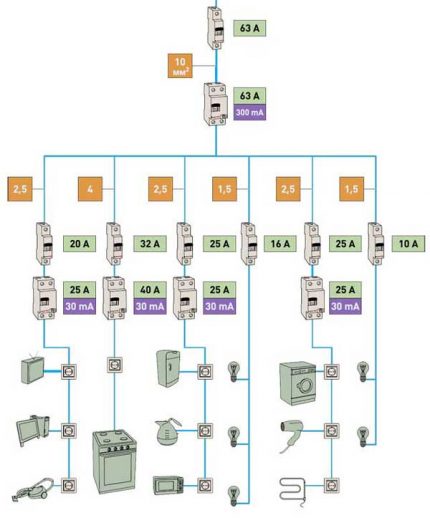
This scheme is practically applicable to any type of housing, but there will be more connection points, respectively, and lines, in 2- and 3-room apartments.
Option # 2: 2-, 3-room apartment
Fundamentally, the electrical wiring does not depend on the number of rooms, but there are a number of features that need to be considered:
- the outlet network is better divided into several groups - according to the number of rooms;
- the lighting system also needs to be divided into rooms;
- at least three lines should be allocated for the kitchen - for lighting devices, powerful equipment and small household appliances;
- if the bathroom is separate, it is better to use the division into 2 groups.
Given that a large area of apartments is characteristic of elite housing, security equipment is included in the wiring diagrams.
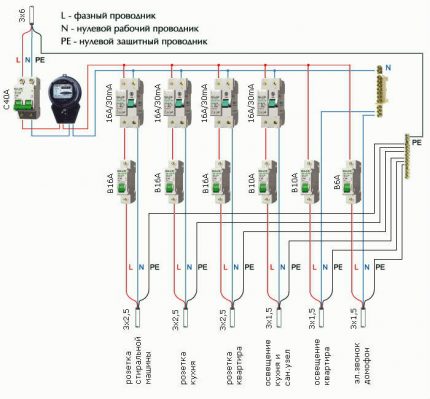
If specialists are involved in the drafting and installation, then you should have a diagram at the end of the work - in case of repair or an unforeseen situation.
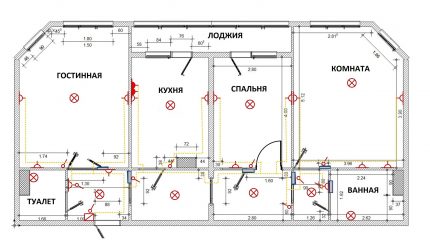
According to the developed scheme for laying electric lines and installing electric points, you can safely perform installation power networks. It is advisable to avoid changes in the planned wiring during work. However, if there is a need for them, the adjustment of the scheme must be done taking into account the above rules.
Making up wiring diagram in a private house, you must specify the input electrical equipment and cable parameters from the input group.
Conclusions and useful video on the topic
You can draw up a wiring diagram in the form of a drawing made by hand, or using a computer program. Example wiring for an apartment in a three-dimensional computer image:
Professional advice from practitioners:
Subtleties of various types of connecting sockets and switches:
To carry out the electrical network in the apartment, protecting all devices and correctly distributing the load, it is possible under one condition - if you are a qualified electrician.
It is impossible to work with a switchboard without special permission. Consequently, you can change the outlet or connect the hood yourself, and more serious work is better to delegate to specialists.
Want to share your personal experience in drawing up a scheme for the modernization or repair of power lines in an apartment? Have questions or valuable suggestions? Please write comments in the block below.

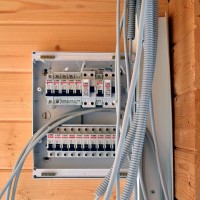 Wiring in the apartment: an overview of the main schemes and the procedure for performing work
Wiring in the apartment: an overview of the main schemes and the procedure for performing work 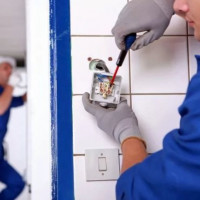 DIY wiring: how to properly perform electrical work
DIY wiring: how to properly perform electrical work 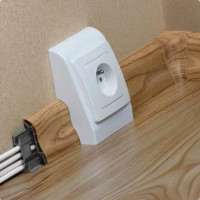 Installation of open wiring: a review of the technology of work + analysis of the main errors
Installation of open wiring: a review of the technology of work + analysis of the main errors 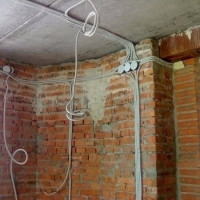 How to conduct wiring in the apartment with your own hands from the shield: basic schemes and rules + installation steps
How to conduct wiring in the apartment with your own hands from the shield: basic schemes and rules + installation steps 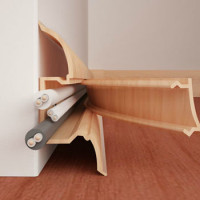 Cable channel for electrical wiring: types of structures and their classification
Cable channel for electrical wiring: types of structures and their classification  Corrugation for electrical wiring: how to choose and install a corrugated sleeve for cable
Corrugation for electrical wiring: how to choose and install a corrugated sleeve for cable  How much does it cost to connect gas to a private house: the price of organizing gas supply
How much does it cost to connect gas to a private house: the price of organizing gas supply  The best washing machines with dryer: model rating and customer tips
The best washing machines with dryer: model rating and customer tips  What is the color temperature of light and the nuances of choosing the temperature of the lamps to suit your needs
What is the color temperature of light and the nuances of choosing the temperature of the lamps to suit your needs  Replacement of a geyser in an apartment: replacement paperwork + basic norms and requirements
Replacement of a geyser in an apartment: replacement paperwork + basic norms and requirements
I would recommend not only in private homes to pay special attention to the creation of lines with different loads, but also to do this in apartments. The fact is that now, in addition to conventional household appliances, many also use additional electric water heaters, which ordinary wiring will quickly fail. Even if such equipment is not used now, it is better to foresee this in the future.
Three months ago we drove into a new odnushka. In the very first week we encountered such a problem - the bathroom is cut down if a washing machine and, for example, a hairdryer are working. As a result, I myself did not dare to disassemble, they called an electrician. They made a normal selection for the bathroom. Why at the same time the kitchen with a bunch of appliances was not cut off - it is not clear, apparently they mounted it as it should. In the bathroom, the lamp also burned out very often.
It was necessary to put the automatic machine on the bathroom more strongly, since one bath was cut down, then the “dedicated line”, and so it is, just put a weak automatic machine.
Good afternoon, Alexander.
You did not provide the circuit details, therefore I will assume that the kitchen was supplied with electricity by a special line, and the installers selected the protection correctly - the rated current of the circuit breaker is implied.Such isolation of the kitchen electrical network is provided for in paragraph 3.26 of Instruction No. I 1.00-12, which regulates the installation of electrical wiring.
The power supply to the bathroom bypassed regulatory documents - this applies only to the power supply circuit of electrical equipment. In other words, a dedicated line is not required. However, SP 256.1325800.2016, which establishes the design rules for apartments, requires protecting the 30 mA RCD line of the bathroom if there are sockets in the room. Under the RCD, it is logical to lay the selected line. A combined screenshot of the mentioned paragraphs of the documents - attached.
The bathroom was cut down, I think, by an improperly selected machine. The washing machine could “burn” the light bulb, distorting the sinusoid voltage with harmonics.
With such an event, there are a lot of options and without proper knowledge, doing nothing on your own. For reasons:
1. Incorrectly selected machine (less cash than required).
2. The RCD circuit breaker (current loss circuit breaker) is not correctly selected.
3. A malfunction of one of the devices (current could go).
4. Not bona fide wiring (there could be a loss in the wires).
In such cases, it is necessary to check, starting with what means of protection are used, a regular automatic machine, an RCD or a differential automatic circuit breaker (not to be confused with an RCD) and proceeding from this, check further. As a rule, one line is enough for a bathroom - light, washing machine (temporary load), sockets (temporary load).
It wasn’t necessary, Roman. The wash should go in a separate line.
Guided by your recommendations and using your picture, I tried to draw up my diagram for a one-room apartment. Can you comment on my mistakes and how to simplify the scheme while maintaining acceptable security.